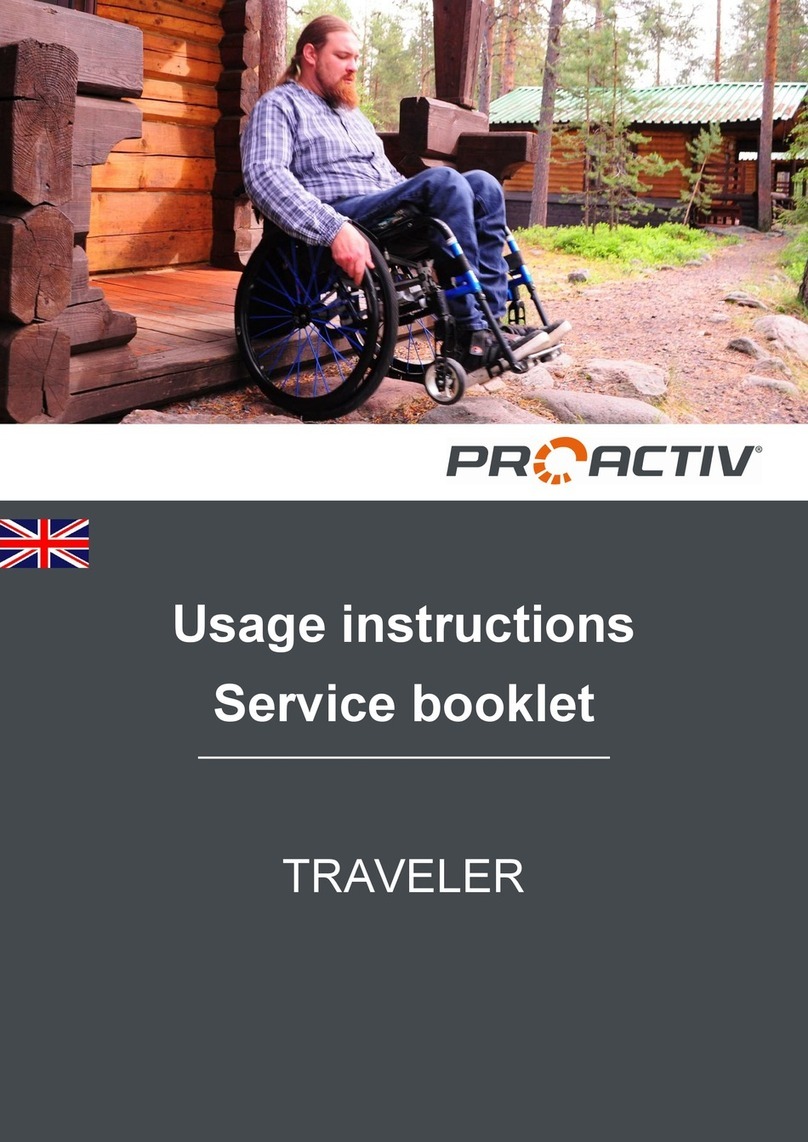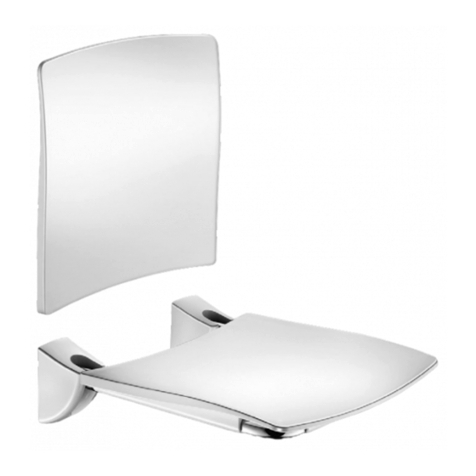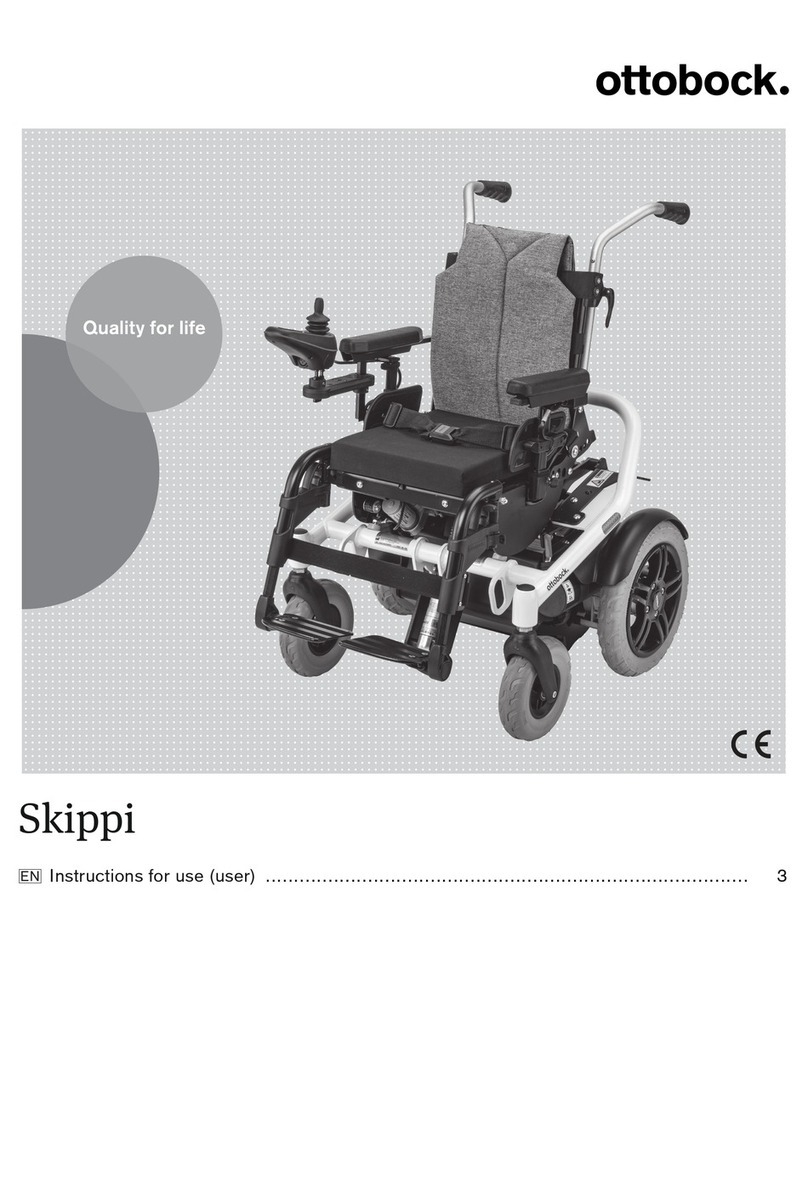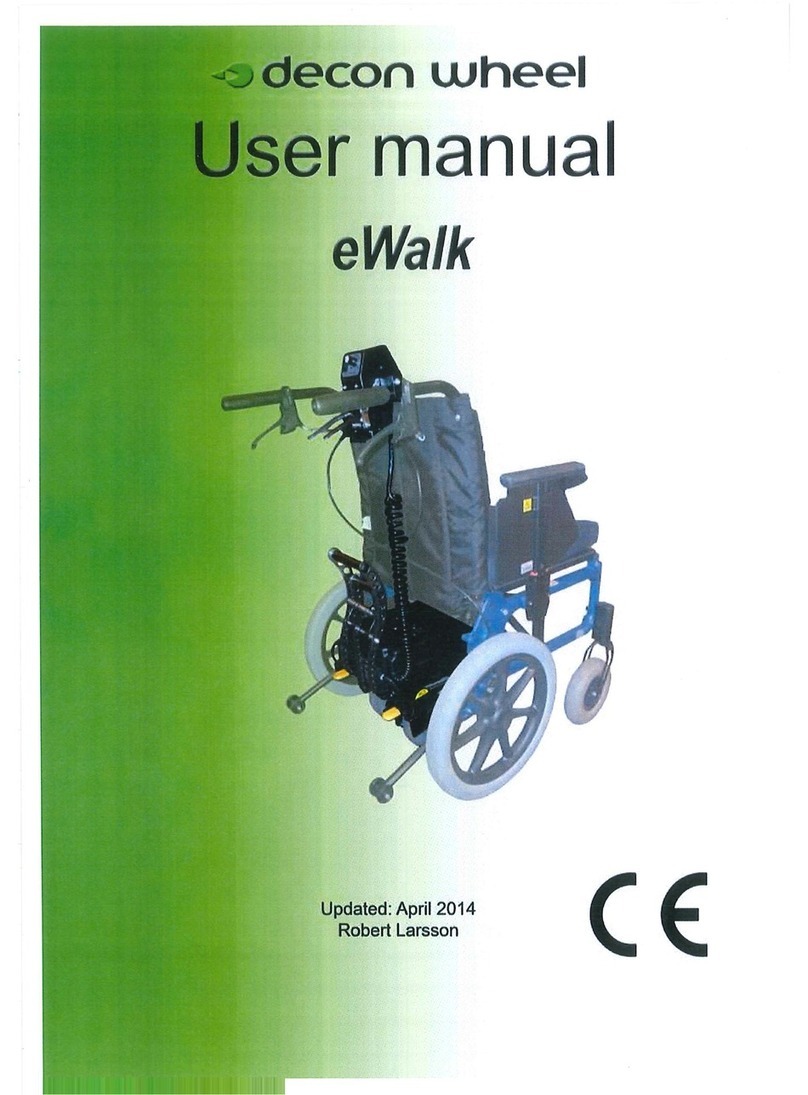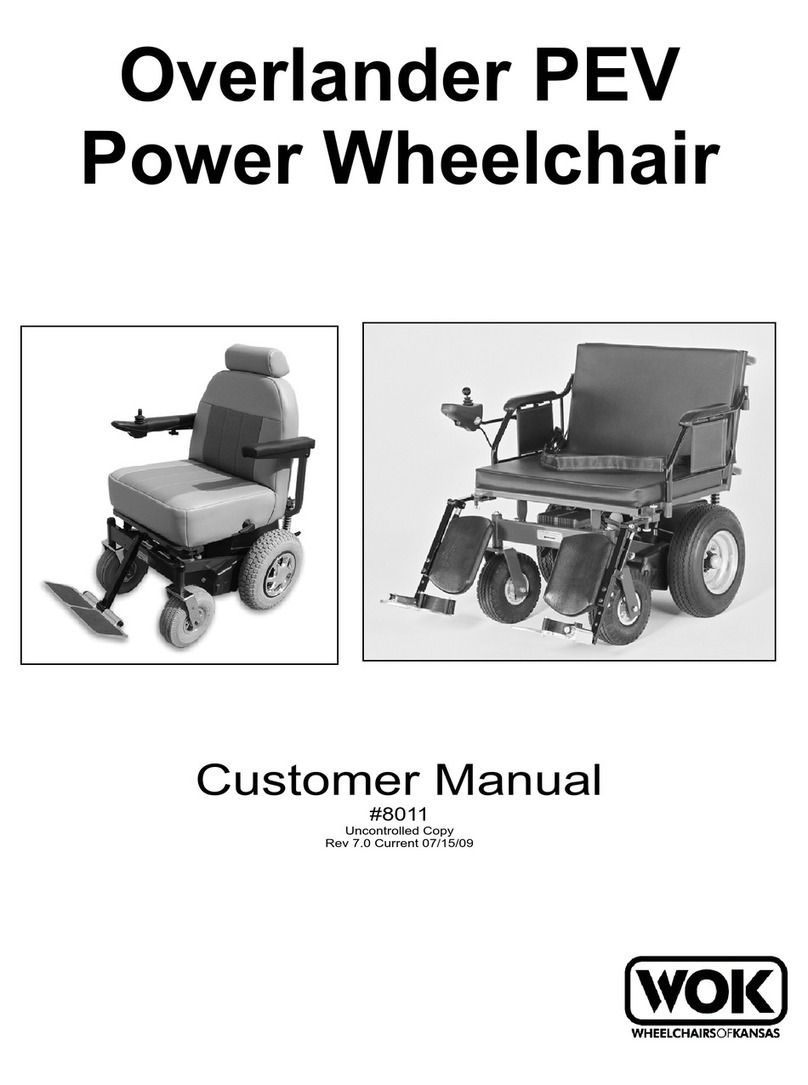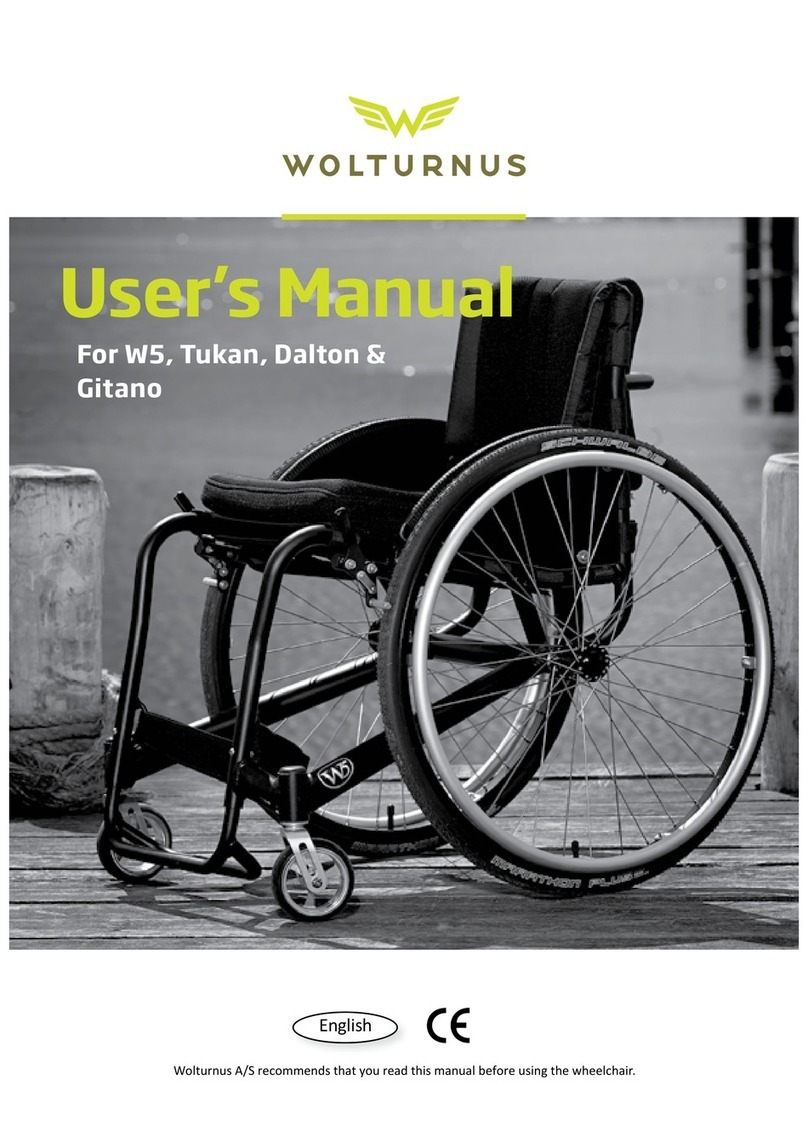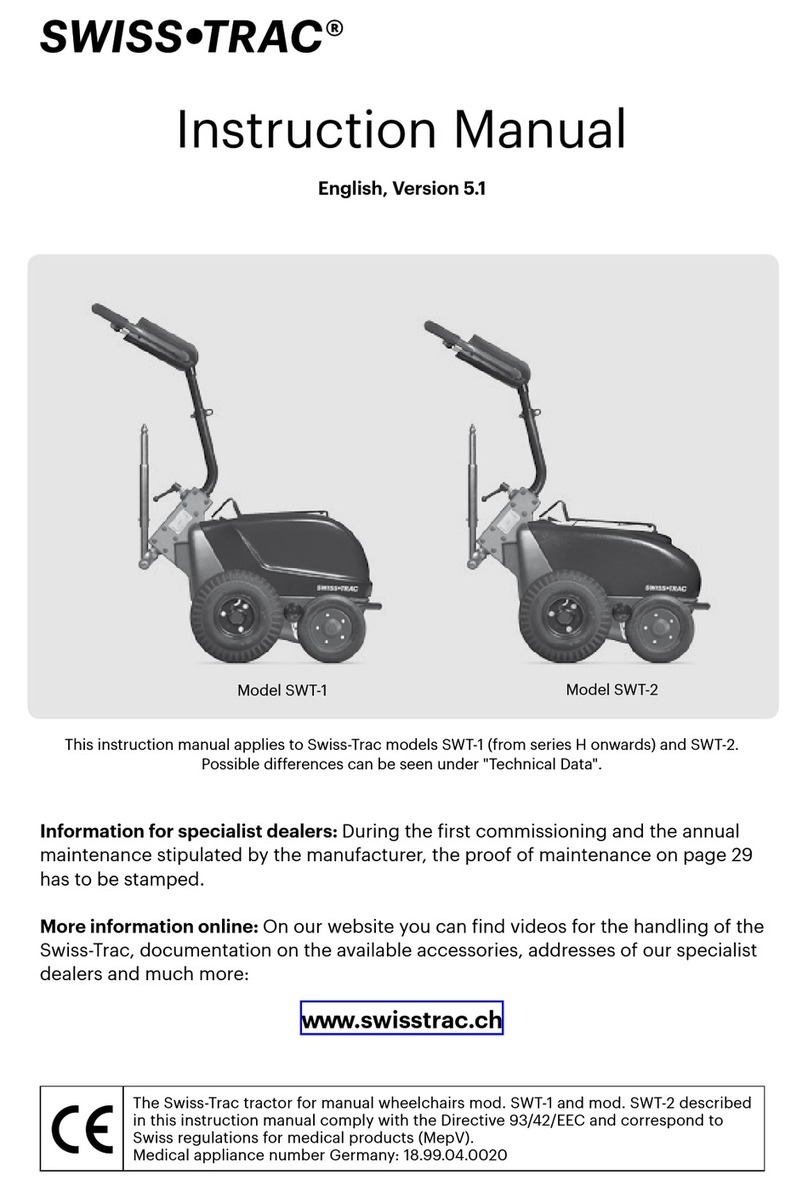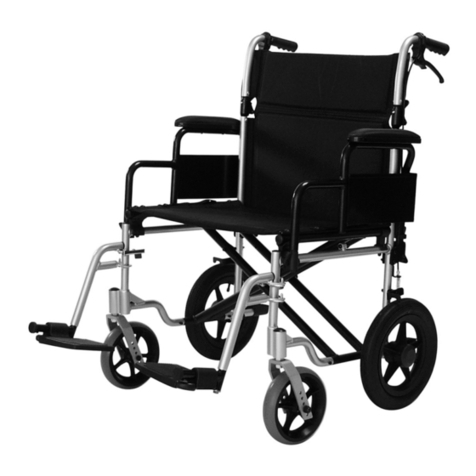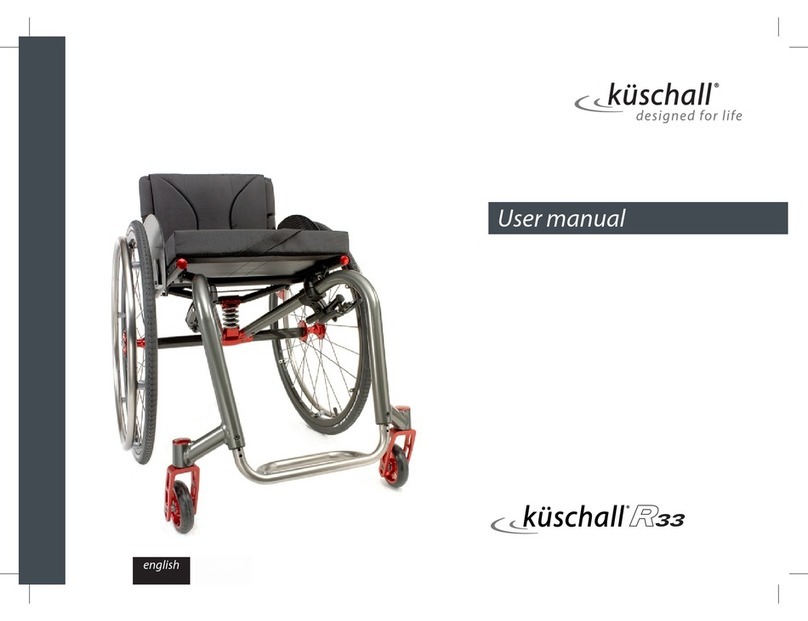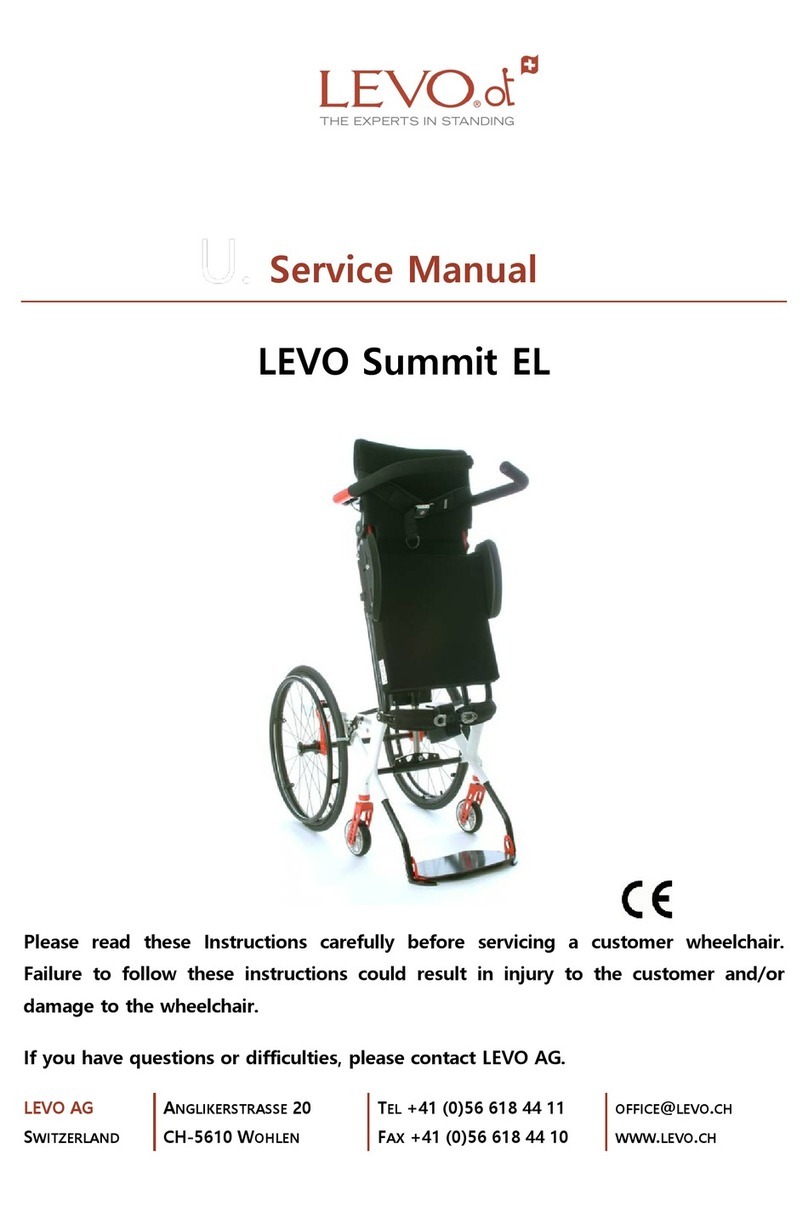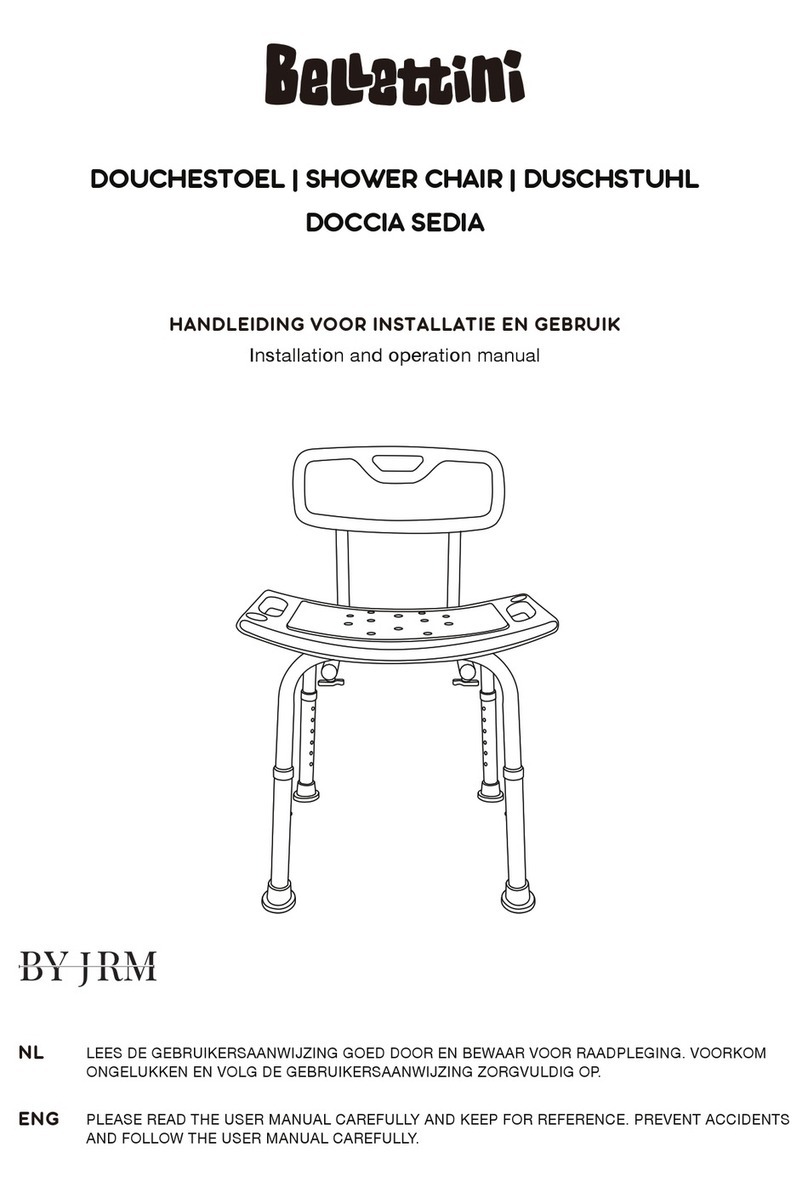AMF-BRUNS Easy-Ramp User manual

Operating Instructions
WHEELCHAIR ACCESS VEHICLE WITH REAR CUT-OUT
www.amf-bruns.de
FORD TRANSIT CONNECT WITH AMF-BRUNS EASY-RAMP AND EASY-FLEX-RAMP


Foreword
Easy-Ramp and Easy-Flex-Ramp Page 3 of 56
Foreword
Dear reader,
these Operating Instructions provide all information neces-
sary to operate the Easy and Easy-Flex wheelchair access
ramps safely.
The access ramp is designed and constructed in accord-
ance with state of the art technology and recognised safety
standards. Persons and materials can however be endan-
gered, as not all danger areas can be eliminated if the func-
tional capability is to be maintained. Accidents caused by
these dangers can however be prevented by strictly ob-
serving these Operating Instructions. Over and above this,
the operational efficiency of the access ramp can be used
to the full and unnecessary faults can be prevented.
After reading these Operating Instructions for the first time,
keep them in a safe place for future reference over the en-
tire lifetime of the vehicle. If you sell the vehicle, hand these
Operating Instructions over to the new owner.
All instructions, figures and dimensions contained in these
Operating Instructions are without obligation. No claims in
any form can be derived from these.
This document must not be reproduced or duplicated, in full
or in part, without the prior, written permission of the man-
ufacturer.
Neither the vehicle nor the access ramp must be converted
or modified in any way, without seeking the prior, written
permission of the manufacturer. The manufacturer will not
be held responsible in any way whatsoever if conversions or
modifications are carried out without authorisation.
Use only original spare parts or spare parts which have
been approved of by the manufacturer. If spare parts other
than these are used, this can have a negative effect on the
specified characteristics, the functionality and safety of the
access ramp. Using non-original or unauthorised spare
parts will render the guarantee null and void.
Contact our customer services department to order spare
parts or accessories (see Chapter 11, page 54).

Foreword
Page 4 of 56 Easy-Ramp and Easy-Flex-Ramp
Explanation of symbols and signs
To improve understanding, the following conventions should
be met for these Operating Instructions.
1.
The following types of special note are used to highlight text
passages of an important nature.
DANGER!
y warns of a situation of immediate danger, which will lead
to serious or fatal injuries, if not avoided.
W
ARNING!
y warns of a potentially dangerous situation, which will lead
to serious or fatal injuries, if not avoided.
CAUTION!
y warns of a potentially dangerous situation, which will lead
to slight or minor injuries,or material damage if not
avoided.
CAUTION!
...warns of a potentially dangerous situation, which can
cause material damage, if not avoided.
...contains general notes and useful information.
...gives a reference to important information in other sec-
t
ions and documents.

Foreword
Easy-Ramp and Easy-Flex-Ramp Page 5 of 56
2.
Some texts serve a particular purpose. These are identified
as follows:
y Lists
Ö Instructional text, e.g. a sequence of activities.
3.
Meaning of directions:
If directions are given in the text (in front of, front, behind,
rear, right, left), these relate to the normal direction of travel
of the vehicle.

Contents
Page 6 of 56 Easy-Ramp and Easy-Flex-Ramp
Contents
Foreword................................................................. 3
Contents.................................................................. 6
1 Safety .................................................................. 8
1.1 Proper Use..............................................................8
1.2 Improper Use ..........................................................9
1.3 Personnel Requirements ....................................... 10
1.4 Product Monitoring ............................................... 10
1.5 Danger Zone .......................................................... 11
1.6 Safety Devices ....................................................... 11
1.7 Safety and Accident Prevention Regulations ......... 12
1.8 Disposal ................................................................ 13
2 Description ........................................................ 14
2.1 Layout and Function.............................................. 14
2.1.1 Ramp............................................................ 15
2.1.2 Floor section................................................. 16
2.1.3 Belts and belt anchorages .............................17
2.2 Rating Plate........................................................... 18
2.3 Operating Controls................................................ 19
2.4 Technical Data ......................................................20
3 Transportation...................................................20
4 Installation / Commissioning .............................20
5 Operation........................................................... 21
5.1 Safety Regulations for Operation........................... 21
5.2 Deploying the Ramp..............................................23
5.3 Loading a Passenger / Wheelchair........................25
5.4 Disembarking a Passenger / Unloading a
Wheelchair ............................................................29
5.5 Unfolding the Rear Seats.......................................30
5.6 Easy-Flex: Stowing the Ramp ...............................32
5.7 Fitting and Removing the Seat Consoles ...............34
5.7.1 Removing the seat console ..........................34
5.7.2 Fitting the seat console.................................35

Contents
Easy-Ramp and Easy-Flex-Ramp Page 7 of 56
6 Maintenance and Repair ...................................36
6.1 Safety Regulations for Maintenance and Repair ....36
6.2 Routine Maintenance Work ................................... 37
6.2.1 Maintenance schedule.................................. 37
6.2.2 Maintenance record ..................................... 37
6.3 Functionally Testing the Electrically Operated
Belts......................................................................38
6.4 Yearly Inspection...................................................39
6.5 Maintenance and Repair Records .........................40
7 De-Commissioning and Conservation .............. 41
8 Troubleshooting ................................................42
9 Inspection Log Book .........................................43
9.1 Inspection Log Book Master Data Sheet...............44
9.2 Inspection List .......................................................45
9.3 Inspection Results.................................................46
10 Electrical circuit diagram ..................................53
11 Customer Service .............................................54

Safety
Page 8 of 56 Easy-Ramp and Easy-Flex-Ramp
1 Safety
CAUTION!
There are a number of risks of suffering personal injury and
material damage involved in the operation and maintenance
of the access ramp.
Therefore:
y It is imperative, that these Operating Instructions are read
thoroughly before operating your access ramp. Always
observe the notes and information contained therein, in
particular the safety instructions.
y If these Operating Instructions or parts thereof are lost or
become illegible, please request a new copy from the
manufacturer.
Prerequisite to the safe handling and trouble-free operation
of the access ramp is a thorough knowledge of the applica-
ble safety information and safety regulations.
It is therefore imperative that this Chapter is read thoroughly
before operating the access ramp and that the instructions
and warnings herein are strictly observed. The safety infor-
mation and warnings, given at the appropriate places in the
following Chapters, must also be strictly observed. The
manufacturer will not be held responsible if safety infor-
mation and warnings are not observed.
In addition to the information given in these Operating In-
structions, local legislative regulations must be taken into
consideration, in particular those regarding safety and acci-
dent prevention.
1.1 Proper Use
The access ramp must only be used for transporting a dis-
abled person in a wheelchair or an empty wheelchair. By
using the access ramp, persons can be loaded into or dis-
embarked from the vehicle to which it is fitted.
When doing so, the access ramp will be operated by an ac-
companying person.
Wheelchairs must be equipped with the fittings necessary
to secure it by means of the belt restraint systems provided.
Proper use also includes strictly adhering to the information
given in these Operating Instructions.

Safety
Easy-Ramp and Easy-Flex-Ramp Page 9 of 56
W
ARNING!
If the access ramp is used for any other purpose than that
described above, this may result in dangerous situations for
persons or material damage being caused.
Therefore:
y Only use the access ramp for the purpose for which it
was intended.
y Always adhere to information given in these Operating In-
structions.
y Do not use the access ramp for any other use, particu-
larly those given in Section 1.2. These are deemed to be
improper use.
1.2 Improper Use
Any type of use, other than that mentioned in section 1.1 is
deemed to be improper use.
The Easy-Flex access ramp is deemed to be improperly
used if for example:
y it is used to transport goods,
y it is used in a faulty state or with safety-relevant malfunc-
tions,
y it is used without protective cladding or safety devices,
y it is used to transport wheelchairs that can not be se-
cured by means of the belt restraint systems provided,
or
y it is used by incompetent persons.

Safety
Page 10 of 56 Easy-Ramp and Easy-Flex-Ramp
1.3 Personnel Requirements
The access ramp must only be handled by persons who:
y have been instructed in how to operate the access ramp,
y have read and understood these Operating Instructions,
y have proven their ability to operate the access ramp to
the vehicle's owner,
y have been expressly assigned by the vehicle's owner to
operate the access ramp,
y have the technical knowledge to operate the wheel-
chair's brakes and switch the motors of electrically driven
wheelchairs ON and OFF and
y are in a position to adapt themselves to the particular be-
haviour and needs of disabled persons.
Transportation, installation, commissioning, maintenance,
repair, fault finding and disposal of the access ramp and the
vehicle itself must only be carried out by persons with the
corresponding technical training and experience.
1.4 Product Monitoring
Please contact AMF-Bruns GmbH & Co. KG immediately if
faults or problems are encountered when operating your
access ramp or if accidents or "near-misses" occur.
AMF-Bruns will effect a solution to the problem with your
help and the knowledge gained will flow into future projects.
NOTE
Guarantee work on the access ramp must only be carried
out with the prior agreement of AMF-
Bruns GmbH & Co. KG.
The costs of such work will not be accepted by AMF-Bruns
without prior agreement.

Safety
Easy-Ramp and Easy-Flex-Ramp Page 11 of 56
1.5 Danger Zone
The danger zone is the area behind the access ramp that is
being deployed, in which a person can be injured through
the movement of the access ramp.
CAUTION!
Risk of injury and danger of material damage when deploy-
ing the access ramp.
There is a risk of injuries to the legs and feet if the access
ramp is allowed to fall to the ground out of control. The ac-
cess ramp can be damaged.
Therefore:
y Keep hold of the access ramp until it is fully in contact
with the ground.
y Allow the access ramp to deploy slowly.
1.6 Safety Devices
Electrically operated belts
Electrically operated belts, with which the wheelchair is se-
cured when driving, are attached to the front area of the
vehicle's floor. These electrically operated belts can only be
pulled out when the ramp has been fully deployed and the
ON/OFF switch is in the "I" position (for operating controls,
refer to Section 2.2, page 18). The electrically operated belts
retract automatically when the ON/OFF switch is in either
position. Before the wheelchair can be pushed or driven up
the ramp, the electrically operated belts must be attached
to the wheelchair and the ON/OFF switch must be set to the
"0" position. This will prevent the wheelchair from rolling
back out of control.

Safety
Page 12 of 56 Easy-Ramp and Easy-Flex-Ramp
1.7 Safety and Accident Prevention
Regulations
Adhere to the following notes in order to prevent personal
injuries and material damage. Adhere also to the relevant
safety and accident prevention regulations laid down by the
trade associations for commercial use.
y The access ramp must only be operated if all safety de-
vices are correctly fitted (see Section 1.6). Such devices
must only be removed in order to enable maintenance
and repair work to be carried out. All safety devices must
be replaced immediately after such work has been com-
pleted. If they are not replaced correctly, there is a high
risk of injury.
y The access ramp must only be used for the purpose for
which it is intended, otherwise dangerous situations, with
resultant injuries, may occur (Proper use: see Section 1.1,
page 8).
y The owner is responsible for ensuring that proper use is
adhered to, in particular that the access ramp is only op-
erated by authorised persons.
y If the access ramp is used commercially or as a public
utility, the owner must ensure that operating personnel
are familiar with the operation of the access ramp under
all operating conditions by giving training and familiarisa-
tion courses.
y Proper use of the access ramp also includes adherence
to the specified maintenance and repair work, in particu-
lar strict adherence to the maintenance intervals. If such
work is not carried out, trouble-free operation can not be
guaranteed. Risks of personal injury and material damage
can occur. We recommend that maintenance records be
kept.
y If the access ramp is used commercially or as a public
utility, it must be inspected by a technical expert at inter-
vals of not more than 1 year after commissioning. During
inspection, faults affecting the safety should be system-
atically identified and remedial action taken (see "Inspec-
tion Log Book", page 43).

Safety
Easy-Ramp and Easy-Flex-Ramp Page 13 of 56
y The access ramp must not be operated in a faulty condi-
tion, as serious injuries may be caused by this. If faults
occur, do not use the access ramp until repairs have
been effected.
y Before carrying out maintenance or repair work, this in-
cludes cleaning work, switch the vehicle's engine OFF
and prevent the vehicle from rolling away by applying the
handbrake. Make certain that no other person can start
the vehicle (e.g. by removing the ignition key). If this is
not done, there is a risk of injury.
y Use only original spare parts or spare parts which have
been approved of by the manufacturer. If non-original or
unauthorised replacement parts are used, this will render
the guarantee null and void.
1.8 Disposal
When the access ramp and vehicle's useful life has expired,
they must only be be disposed of by qualified specialists.
The manufacturer will accept no liability for damage caused
by incorrect disposal.

Description
Page 14 of 56 Easy-Ramp and Easy-Flex-Ramp
2 Description
Persons who are wheelchair-bound can be loaded into or
disembarked from a vehicle via the access ramp.
The main components of the access ramp are:
y the ramp,
y the floor section,
y the belts and retractors for securing the wheelchair.
The aim of this chapter is to illustrate the construction and
function of the access ramp. To this end, the individual as-
semblies and components are described in the following
sections.
2.1 Layout and Function
Figure 1: Ramp in the Deployed Position
RampFloor section

Description
Easy-Ramp and Easy-Flex-Ramp Page 15 of 56
2.1.1 Ramp
The Easy-Ramp is used in two positions.
In the completely deployed position, the ramp provides a
slope, via which the wheelchair can be easily pushed or
driven into the vehicle (see Figure 1, page 14).
In the vertical position, the access ramp leaves sufficient
space for a passenger or empty wheelchair. In this position,
the frame of the access ramp fills the gap in the vehicle's
rear bumper. The vehicle's rear doors or tailgate can be
closed (see Figure 2).
Figure 2: Easy-Ramp in the Vertical Position
A third position is available for the Easy-Flex-Ramp. The
ramp can be folded down into the vehicle so that it rests on
the floor of the vehicle.
The floor section is almost completely covered. This creates
a level luggage compartment floor. The vehicle can be used
without difficulty to transport goods and other items, up to
a weight of 100 kg, in the normal way (see Figure 3,
page 16).
Ramp
Frame

Description
Page 16 of 56 Easy-Ramp and Easy-Flex-Ramp
Figure 3: Fully Stowed Easy-Flex-Ramp
2.1.2 Floor section
The floor section offers sufficient space for the passenger in
the wheelchair. The surface of the floor section is lower than
the floor of the original vehicle. This ensures that the pas-
senger has sufficient headroom. Attachment points are pro-
vided in the front area of the floor section for a seat console,
which supports the original rear seats or a single smart seat
(optional) (see Figure 4).
Figure 4: Floor section
Ramp
Seat console attachment points
Floor
section
Fittings
Electrically
operated
belt
Electrically
operated
belt

Description
Easy-Ramp and Easy-Flex-Ramp Page 17 of 56
For short wheelbase vehicles, foldaway seat supports are
provided in the mid area of the floor section. The rear seats
engage in these seat supports when they are folded back
to the normal position (see Section 5.5, page 30)
2.1.3 Belts and belt anchorages
Two electrically operated belts are fitted to the front area of
the floor section (see Figure 4, page 16). The electrically op-
erated belts can be pulled out when the ramp is fully de-
ployed and the ON/OFF switch in the vehicle is set to the "I"
position.
Fittings, to which the retractor belts can be attached, are
provided on the rear area of the floor section (see Figure 5).
The rear end of the wheelchair is secured by the retractor
belts.
Figure 5: Retractor Belts and Fittings
Retractor belts
Fittings
Floor section

Description
Page 18 of 56 Easy-Ramp and Easy-Flex-Ramp
2.2 Rating Plate
A rating plate, which contains the fundamental data, is at-
tached to the access ramp (see Figure 6).
Figure 6: Rating Plate
Designation
Serial
number
Series and type
designation
Load bearing ca-
pability
Year of
manufacture
Manufacturer's
data

Description
Easy-Ramp and Easy-Flex-Ramp Page 19 of 56
2.3 Operating Controls
Figure 7: ON/OFF Switch
Figure 8: Operating Levers
Designation Function
ON/OFF Switch Allows the electrically oper-
ated belts to be pulled out
Operating lever 1 Allows the ramp to be de-
ployed.
Operating lever 2
(only for Easy-Flex)
Allows the ramp to be folded
down inside the vehicle to the
horizontal position.
OFF ON
Operating lever 2
Stowing the Access Ramp
(only for Easy-Flex)
Operating lever 1
Deploying the ramp

Transportation
Page 20 of 56 Easy-Ramp and Easy-Flex-Ramp
2.4 Technical Data
Designation Easy-Ramp
Easy-Flex-Ramp
Maximum load (wheelchair use) 300 kg
Maximum load (Easy-Flex-Ramp
stowed position, luggage compart-
ment)
100 kg
3 Transportation
Transportation of the access ramp is carried out by the
manufacturer or by trained, experienced personnel.
4 Installation / Commissioning
The access ramp must be installed in accordance with the
A
MF-Bruns Installation Instructions applicable to the vehicle
in question.
DANGER!
Risk of danger through incorrect installation.
A
number of risks of personal injury and material damage
can be caused if the access ramp is incorrectly installed in
t
he vehicle.
Such risks of danger can not only occur during installation
but also as a result of installation not being carried out cor-
rectly.
Therefore:
y The access ramp must only be installed by specialist per-
sonnel, who have been trained for this job by the manu-
facturer. This also applies to the electrical connections.
y The vehicle manufacturer's body fitting guidelines must
be adhered to.
y A technical expert must be called in to inspect the access
ramp for correct installation and the effectiveness of the
safety devices.
y The technical expert must confirm the fact that opera-
tional safety of the access ramp has been established b
y
making a corresponding entry in the inspection log boo
k
(see Chapter 9, page 43).
y The access ramp must not be used until this has been
done.
Other manuals for Easy-Ramp
4
This manual suits for next models
1
Table of contents
Other AMF-BRUNS Wheelchair manuals



